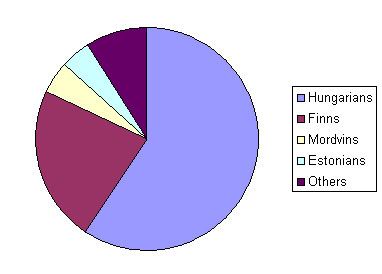Hungary 9,982,000 Russia 2,322,000 Romania 1,227,623 | Finland 4,948,400 United States 2,288,100 Estonia 936,000 | |
 | ||
The Finno-Ugric peoples are any of several peoples of Eurasia who speak languages of the Finno-Ugric group of the Uralic language family, such as the Khanty, Mansi, Hungarians, Maris, Mordvins, Sámi, Estonians, Karelians, Finns, Udmurts and Komis.
Contents
- Extinct ethnic groups
- Finno Ugric identity
- Mythology
- International Finno Ugric societies
- Population genetics
- Archaeology
- References
The four most numerous Finno-Ugric peoples are the Hungarians (13–14 million), Finns (6–7 million), Estonians (1.1 million) and Mordvins (744,000). The first three of these have their own independent states – Hungary, Finland, and Estonia. The traditional area of the indigenous Sami people is in Northern Fenno-Scandinavia and the Kola Peninsula in Northwest Russia and is known as Sápmi.
Some other Finno-Ugric peoples have autonomous republics in Russia: Karelians (Republic of Karelia), Komi (Komi Republic), Udmurts (Udmurt Republic), Mari (Mari El Republic), and Mordvins (Moksha and Erzya; Republic of Mordovia).
Khanty and Mansi peoples live in Khanty–Mansi Autonomous Okrug of Russia. Komi subgroup Komi-Permyaks used to live in Komi-Permyak Autonomous Okrug, but today this area is a territory with special status within Perm Krai.
Extinct ethnic groups
Finno-Ugric identity
In Finnic- and Ugric-speaking countries such as Finland, Estonia and Hungary that find themselves surrounded by unrelated tongues, language origins and language history have long been relevant to national identity.
Vladimir Lenin may have had Mordvin ancestry.
There is a belief that President Vladimir Putin of Russia is potentially of Vepsian ancestry.
Mythology
Shamanism has had a historically important influence on the mythologies of Siberian peoples, including the Finnic, Ugric, Yeniseian, Turkic, Mongolic, Tungusic, and other northern Eurasia and Central Asian peoples. A central concept in their cosmologies is the myth that the world was created from an egg. There are also myths about the Milky Way, ideas about the existence of the World tree or pillar, and the idea that asterisms represent animal spirits. A myth about a bird floating on the primary ocean that dives for the ground is a central Uralic cosmogonic myth.
International Finno-Ugric societies
In 1992, the 1st World Congress of Finno-Ugric Peoples was organized in Syktyvkar in the Komi Republic in Russia, the 2nd World Congress in 1996 in Budapest in Hungary, the 3rd Congress in 2000 in Helsinki in Finland, the 4th Congress in 2004 in Tallinn in Estonia, the 5th Congress in 2008 in Khanty-Mansyisk in Russia, and the 6th Congress in 2012 in Siófok in Hungary. The members of the Finno-Ugric Peoples' Consultative Committee include: the Erzyas, Estonians, Finns, Hungarians, Ingrian Finns, Ingrians, Karelians, Khants, Komis, Mansis, Maris, Mokshas, Nenetses, Permian Komis, Saamis, Tver Karelians, Udmurts, Vepsians; Observers: Livonians, Setos.
In 2007, the 1st Festival of the Finno-Ugric Peoples was hosted by President Vladimir Putin of Russia, and visited by Finnish President, Tarja Halonen, and Hungarian Prime Minister, Ferenc Gyurcsány.
Population genetics
A study of Population Genetics of Finno-Ugric speaking humans in North Eurasia carried out between 2002–2008 in the Department of Forensic Medicine at the University of Helsinki showed that most of the Finno-Ugric speaking populations possess an amalgamation of West and East Eurasian gene pools, genetic drift, and recurrent founder effects. North Eurasian Finno-Ugric-speaking populations were found to be genetically a heterogeneous group showing lower haplotype diversities compared to more southern populations. North Eurasian Finno-Ugric-speaking populations possess unique genetic features due to complex genetic changes shaped by molecular and population genetics and adaptation to the areas of Boreal and Arctic North Eurasia.
The proposal of a Finno-Ugric language family has led to the postulation not just of an ancient Proto–Finno-Ugric people, but that the modern Finno-Ugric–speaking peoples are genetically related. Such hypotheses are based on the assumption that heredity can be traced though linguistic relatedness. However, Finno-Ugric has not been reconstructed linguistically; attempts to do so have been indistinguishable from Proto-Uralic.
Like in any other human population, individual groups within the Finno-Ugric language family have a diverse array of cultural, environmental, and genetic influences. However, modern genetic studies have shown that the Y-chromosome haplogroup N3, and sometimes N2, having branched from haplogroup N, which, itself, probably spread north, then west and east from Northern China about 12,000–14,000 years ago from father haplogroup NO (haplogroup O being the most common Y-chromosome haplogroup in Southeast Asia), is almost a specific trait, though certainly not restricted, to Uralic- or Finno-Ugric-speaking populations, especially as high frequency or primary paternal haplogroup.
A recent study has found that haplogroup NO of the Finno-Ugric peoples and their descendants probably spread north, then west and east from Northern China about 12,000–14,000 years ago from its father lineage and today is found in Eastern Europe. The Department of Forensic Medicine at the University of Helsinki showed that most of the Finno-Ugric speaking populations possess an amalgamation of West and East Eurasian gene pools, supporting the idea of mixed origins in these modern populations.
R1a1a7-M458
R1a1a7-M458 frequency peaks among Slavic and Finno-Ugric peoples.
R1a1a1i (Z280+)
This group seems to have connection with among others the Finno-Ugric peoples. It is the North-East European subclade of R1a1a1 and spread from the Baltic to the Ural Mountains as well as the Carpathian Basin. The majority of the Steppe Magyars likely belonged to this haplogroup, carrying the Ugric Hungarian language.
